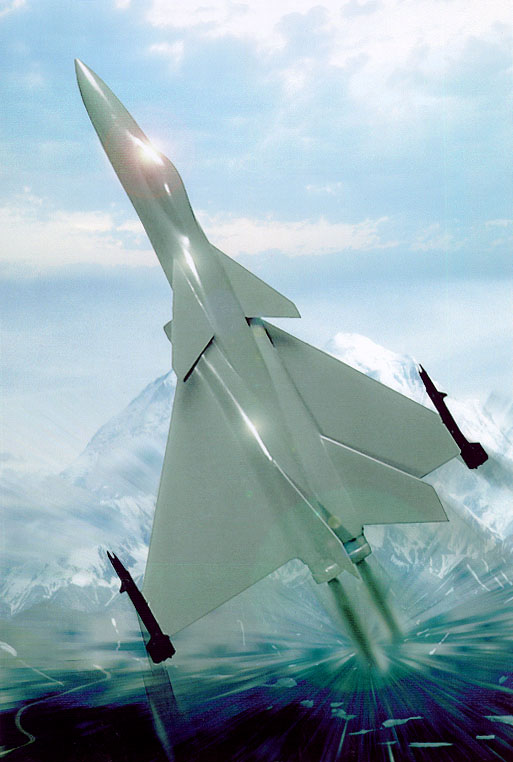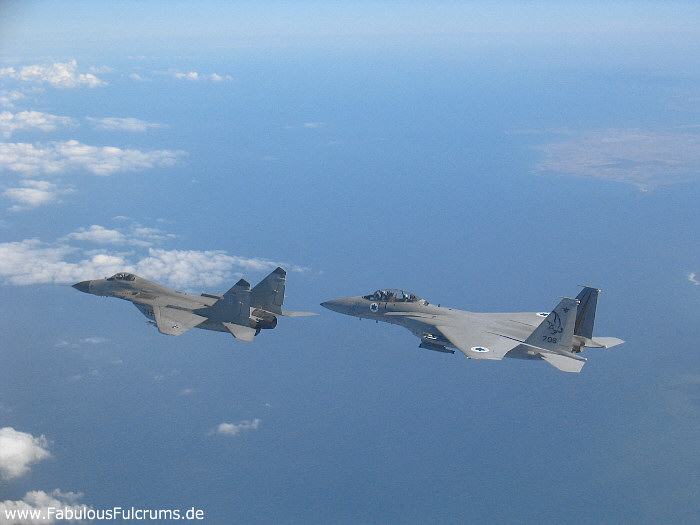salu2:
te refieres a este:
arie

In the mid-70s a group of IAI (Israel Air Industries) engineers and IAF (Israeli Air Force) officers began a new project to develop an ultra modern Israeli fighter aircraft – a project that was to become a quantum leap for the IAI.
Designed to be the most advanced of its kind in the world by any standards, the Arie (Lion), would give the IAF a reliable option to the advanced US F-15 and F-16. Although it has never came through, the Arie became the cornerstone of another future and most ambitious project ever, an Israeli breakthrough to develop and produce the Lavi, the Israeli dream aircraft to outmatch the F-16.
Background
In response to the French embargo forced upon Israel after the Six-day war in 1967, a decision was made to strive for independence in the development of major weapons systems.
The commander of the IAF (1982-1987), Gen. Amos Lapidot: “The essence was to create a technological infrastructure to develop and manufacture weapons systems in the three major weapons systems platforms – tank, aircraft and ship. Behind that concept, were three basic rationales: First, Israel should not, and could not rely on foreign countries' so volatile foreign policies. Secondly, the Israeli air force always striving to develop and use new war tactics and strategies, was in constant need of new equipment to fulfill those operational objectives. Third, a national strategy to promote Israel 's and IAI's state-of-the-art technological accomplishments.
Development
In 1974, an IAI team was set up to begin the Arie project. As no government approval had yet been received to produce it, the program was codenamed “R&D project”. Ovadia Harrari, who would later become head of the Lavi program, was to lead that endeavor.
The IAI decided to develop the Arie based on the technological knowhow acquired from the Kfir project, particularly from the Kfir-Canard program – Its improved version. In fact, the first proposal which was put on hold by the air force, was to develop an aircraft to be be named “Super Kfir” – a regular Kfir whose original J79 engine was replaced by an F100 model, same as in earlier F-15/F-16s versions. That new engine would substantially increase the Super-Kfir's flying performance. However, due to the Air Force's strict specs requirements, a new draft was called for, inspite of the Kfir/Arie's visual similarities.
Over thirty different configurations were evaluated. The IAI tested several engine models, including the European RB-199, which powered the Tornado aircraft. Soon, the options were reduced to two. The F-100 single engine plane, or a twin-engine version.
The later, codenamed Light Weight Fighter-4 (LWF-4), was to be powered by two General-Electric F-404 engines as in the F-18. “Looking at the different designs of the Arie, one can notice that it is an extensively modified Kfir” explains Harrari ,“ the aircraft is visually different, but its roots are based on the Kfir”.
The new future fighter aircraft, which was now codenamed “Hadish” (innovative), could be described as a single seat light fighter, capable of reaching 2.4 Mach speed, a 75,000 ft altitude ceiling, with a 480 km combat radius. Armamment: 30-mm cal. gun and medium range air-to-air missiles. Avionics would include a radar, a helmet sight and an integral electronic warfare system. In addition, the aircraft would have low optical and radar signatures. Even the US F-15 and F-16 could not match these features at that time.
The outstanding factor: An air-to-air fighter, or an air-to-ground attack aircraft?
During its initial phases, the 1973 Yom-Kippur war broke out, and the Israeli air force focused its attention on the battle proven air-to-air configuration concept, as air power and air superiority consist basically of air-to-air combat missions. Therefore, about 90 percent of the “Hadish” capabilities would be directed for air-to-air combat.
Technologies and Avionics
The Arie had several technological breakthroughs. It was designed to be the first Israeli aircraft to deploy digital fly-by-wire flight control system (at that time, point technology). This fly-by-wire concept, permitted the engineers to design an aerodynamically non-stable platform. Hence, they could achieve a smaller and highly maneuverable aircraft.
In the air-to-air version, to cope with enemy intruder aircrafts, and keeping its air-superiority capabilities, the Arie would be equipped with advanced avionics and special ordnance systems: a highly sensitive Israeli Radar capable of acquiring low-altitude flying targets. Advanced electro-optical systems would enable the Arie to locate ground targets at night.
Another breakthrough, was the pilot's option to use his helmet mounted sight, easing his combat workload. In the mid-70's these systems were nearly nonexistent. For example, it would take another ten years for the helmet mounted sight to become operational in any type of combat aircraft.
The Arie's cockpit resembles to a great extent, that of the F-16's early versions. Besides the Head-up Display (HUD), a Monochromatic Display was mounted in the cockpit for Radar data display.
Pilot's view was close to 360º visibility– a life and death factor in air combats.
The Arie's ordnance would include a 30-mm improved Dapa cannon, assorted air-to-air missiles, iron bombs, and TV and Laser guided ordnance. Max. military load:7 tons.
Although that aircraft was not meant to be a stealth aircraft, some primitive stealth capabilities were studied to give it the option to strike heavily fortified missile zones. This objective was based on the lessons learned during and after the 1973 Yom-Kippur war, when Israeli fighters had to face a huge number of SAMs. The Arie would also be equipped with an advanced Electronic-Warfare system produced by Israel , giving that aircraft an early warning signal to lock on in enemy threats and jam them.
Studies were made to drastically reduce its radar signature, making it extremely difficult to be detected by enemy radar. For example, its bomb load was to be stowed inside a conformal ventral capsule, to reduce its radar cross section.
A Paper's Lion
According to the program timetable, the Arie's initial development phase should be completed by mid 1979. Until then, the IAI would have to complete flight test, select and define all the contractors.
By year's end, an initial test flight was scheduled for the first of three prototypes.
In mid 1980, 10 pre-production aircrafts should be completed, with regular production to begin in the following two years. The Air Force should be receiving the first production Arie by the end of 1983. Delivery of 100 aircrafts would be completed by the end of 1985.
Meanwhile, the IAF was leaning towards the US aircraft option. Rumors indicated that the USA would finally agree to sell Israel F-15s and F-16s. Finally, a decision was made to order the US aircrafts.
In august 1975, the IAF's chief, the (late) Gen. Benny Peled realeased a document defining the IAF's policy in relation to the Arie project. The document favored the US F-15s and F-16s. Based on his assessment, the IAF began a procurement program of F-15s to be delivered by 1976. Moreover, it had been determined that the F-16 in principle, answered Israel 's operational needs for an air superiority aircraft for the 80s. As a result of intense pressure on the IAF, Gen. Benny Peled decided to respond with a letter on May 10, 1976 , stating the reasons not to select the Arie: The US would agree to sell Israel F-16s. It had also been agreed that the US would sell Israel the F-100 engine, and there were no sufficient funds to keep the project moving.
“The fundamental knowledge that led to the development of the Lavi relied on the experience acquired from the “Hadish” and Arie”, says Gen. Lapidot, who created the Lavi project board, and commanded the Israeli Air Force by the time the project was canceled. “It can be definitely stated that the Arie, the Nesher and Kfir programs, added significantly to the development of the Israel Aircraft Industry (IAI), so that when we gave the “go ahead” for the Lavi, we already had a complete infrastructure in place and ready to work. In 1980, we decided to build a smaller version of the Arie. It is not by coincidence that it was named the Lavi. Lavi is a Lion (Arie), although a very young and smaller one”
Type Single-seat, multi-role aircraft
Max. speed 2.4 Mach
Max. altitude 75,000 feet
fuente y mas informacion:www.israeli-weapons.com













